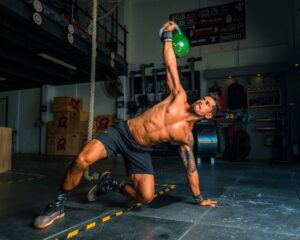Calisthenics for Beginners delves into the art of leveraging one’s own body weight for resistance training. Stemming from the Greek words “kallos” (beauty) and “sthenos” (strength), calisthenics offers a return to foundational fitness methods. As gym culture continues to grow, there’s a parallel surge in enthusiasts who advocate for this age-old, equipment-free approach. If the appeal of a sculpted physique without the burden of gym fees or high-end equipment resonates with you, then calisthenics might just be your ideal path.
Table of Contents
History and Background of Calisthenics
Throughout history, individuals from diverse cultures have harnessed the simplicity and efficacy of calisthenics to achieve peak physical condition. These exercises, which utilize one’s own body weight, transcend equipment and technological advancements, offering a timeless approach to building strength and agility. Embraced by warriors, athletes, and fitness enthusiasts alike, calisthenics continues to be a universal language of physical prowess and discipline.

Benefits of Calisthenics for Beginners
- No Equipment Required: Turn your living room, park, or beach into your personal gym.
- Functional Fitness: Make daily tasks like lifting and reaching more effortless.
- Adaptability: Modify exercises to your fitness level and see steady progression.
- Full Body Workout: Engage multiple muscles and reap comprehensive benefits.
- Flexibility and Mobility: Elevate your body’s agility, reducing injury risks.
Essential Calisthenic Movements for Beginners

When beginning your journey, it’s crucial to lay a solid foundation by mastering the basics before advancing to more complex movements. Understand that a muscle-up will only come after proficiency in pull-ups has been achieved. Diving in headfirst without proper progression can not only lead to discouragement but also increase the risk of injury. It’s essential to prioritize building strength gradually, ensuring you remain active and motivated, rather than sidelining yourself with setbacks.
- Push-Up: The quintessential upper body workout. Start on your knees if a standard push-up feels challenging.
- Squat: A powerhouse move for the legs. Ensure knees don’t extend beyond your toes.
- Lunges: Great for leg strength and balance. Keep your spine straight.
- Plank: Strengthen that core! Start with short durations, gradually building endurance.
- Burpees: A full-body workout that also boosts cardiovascular health.
- Dips: Using stable chairs or benches, dips are great for your triceps.
- Bridge: Amp up your lower back, glutes and core which is fundamental to strength training.
Progression and Setting Challenges
Consistency is the golden word in any fitness journey. Calisthenics for beginners can be challenging. As you find your rhythm and grow more comfortable, it’s beneficial to incrementally increase repetitions and incorporate advanced variations.
Consider setting monthly challenges to keep yourself motivated and engaged. However, it’s essential to recognize and celebrate every milestone, no matter how small. Always remember, the aim is continual progress, not unattainable perfection. Embrace every step of your journey and the growth it brings.
Combining Calisthenics with Other Activities
To prevent plateaus and make your routine more holistic:
- Run or Walk: After a calisthenics session, go for a run or brisk walk.
- Weights: Use calisthenics as a warm-up for targeted weight training.
- HIIT: Incorporate bodyweight exercises into high-intensity interval training routines.
Safety Tips and Avoiding Common Mistakes
Prioritize safety:
- Warm-Up: Essential to prep your body and prevent injuries.
- Form: Incorrect postures can hurt you. Take time to learn the right techniques.
- Rest: Overtraining is counterproductive. Listen to your body.
Transitioning to Advanced Calisthenics: Taking the Leap

As you grow stronger and more comfortable with the foundational exercises, you might find yourself yearning for a new challenge. Advanced calisthenics movements not only require strength but also a heightened sense of balance, coordination, and core stability. Here’s how you can smoothly transition:
Strength and Stability First: Before trying advanced moves, ensure you can easily complete multiple sets of the foundational exercises. For example, if you’re aiming for one-arm push-ups, first be sure you can do at least 30-40 standard push-ups effortlessly.
Progressive Overload: Gradually increase the intensity of your workouts. This can mean more reps, longer hold times, or moving to a slightly more challenging variation of an exercise.
Incorporate Intermediate Movements:
- Archer Push-Ups: These emphasize one arm more than the other, preparing you for one-arm variations.
- Pistol Squats: A single-leg squat that demands strength and balance.
- Tuck Jumps: Boosting explosiveness and cardiovascular fitness.
Explore Advanced Movements:
- Muscle-Ups: A combination of a pull-up and a dip, executed on a bar.
- Front and Back Levers: These require significant core strength and are done hanging from a bar.
- Human Flag: A supreme test of core and upper body strength.
- Planche: Holding your body parallel to the ground, supported only by your hands.
Flexibility and Mobility:

This becomes even more crucial as you progress. Incorporate stretching and perhaps yoga into your routine to maintain flexibility, which is key for advanced movements. Keep in mind that as we age, our natural mobility decreases without proper training. It’s extremely important that we continue to stay in motion. The old adage “use it or lose it” comes in to play here.
Stay Educated and Inspired:
Watch videos of calisthenics experts, join online forums, or consider hiring a coach. As you move into advanced techniques, proper guidance can be invaluable.
Patience and Persistence:
Advanced calisthenics can test your patience. You might spend weeks or even months perfecting a move. Celebrate small victories and remember: it’s a journey, not a sprint.
With the right approach and mindset, advancing in calisthenics can be both challenging and immensely rewarding. Remember to always listen to your body, and ensure you’re progressing at a pace that’s right for you.
Conclusion
Calisthenics, with its roots deep in history and functionality, offers a refreshing, sustainable approach to fitness. It’s not about heavy weights but about mastering your own body weight. As you embark on this journey, remember to enjoy every push-up, every lunge, and every moment of self-discovery.




